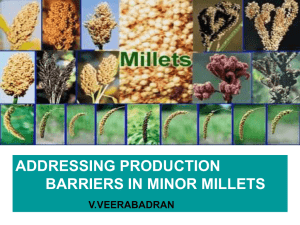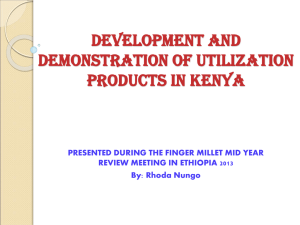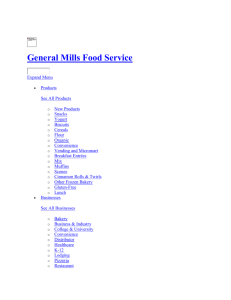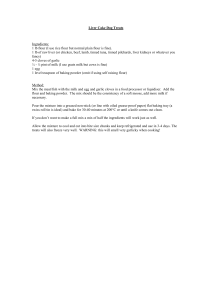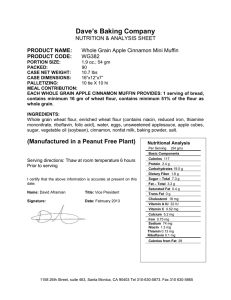Document 14671419
advertisement
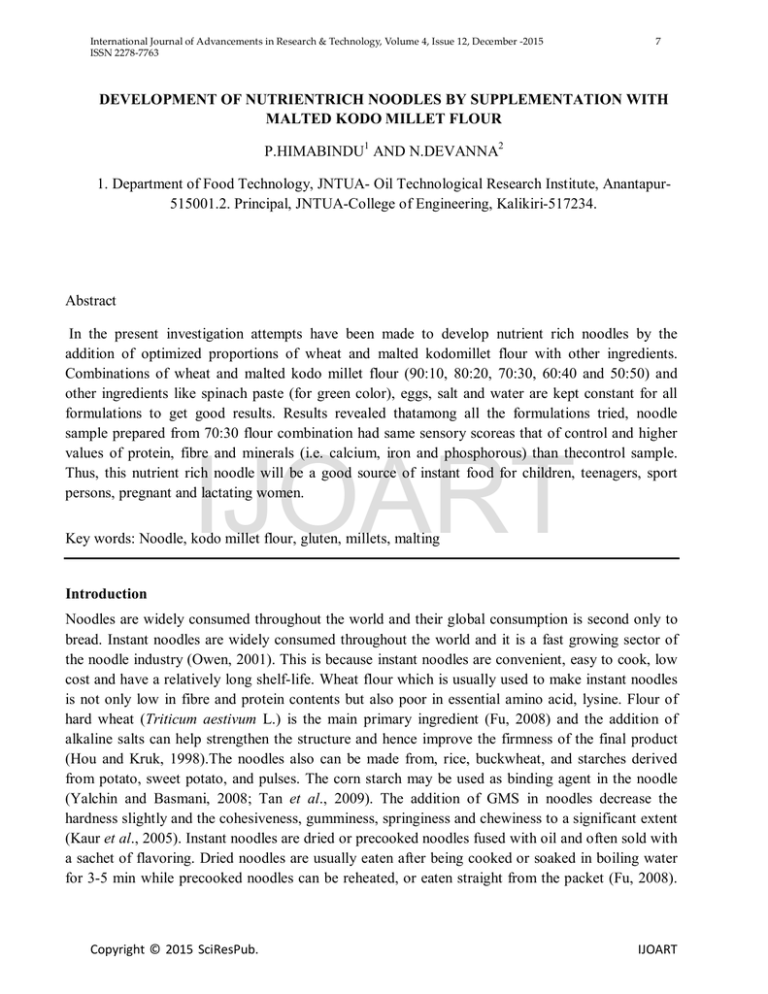
International Journal of Advancements in Research & Technology, Volume 4, Issue 12, December -2015 ISSN 2278-7763 7 DEVELOPMENT OF NUTRIENTRICH NOODLES BY SUPPLEMENTATION WITH MALTED KODO MILLET FLOUR P.HIMABINDU1 AND N.DEVANNA2 1. Department of Food Technology, JNTUA- Oil Technological Research Institute, Anantapur515001.2. Principal, JNTUA-College of Engineering, Kalikiri-517234. Abstract In the present investigation attempts have been made to develop nutrient rich noodles by the addition of optimized proportions of wheat and malted kodomillet flour with other ingredients. Combinations of wheat and malted kodo millet flour (90:10, 80:20, 70:30, 60:40 and 50:50) and other ingredients like spinach paste (for green color), eggs, salt and water are kept constant for all formulations to get good results. Results revealed thatamong all the formulations tried, noodle sample prepared from 70:30 flour combination had same sensory scoreas that of control and higher values of protein, fibre and minerals (i.e. calcium, iron and phosphorous) than thecontrol sample. Thus, this nutrient rich noodle will be a good source of instant food for children, teenagers, sport persons, pregnant and lactating women. IJOART Key words: Noodle, kodo millet flour, gluten, millets, malting Introduction Noodles are widely consumed throughout the world and their global consumption is second only to bread. Instant noodles are widely consumed throughout the world and it is a fast growing sector of the noodle industry (Owen, 2001). This is because instant noodles are convenient, easy to cook, low cost and have a relatively long shelf-life. Wheat flour which is usually used to make instant noodles is not only low in fibre and protein contents but also poor in essential amino acid, lysine. Flour of hard wheat (Triticum aestivum L.) is the main primary ingredient (Fu, 2008) and the addition of alkaline salts can help strengthen the structure and hence improve the firmness of the final product (Hou and Kruk, 1998).The noodles also can be made from, rice, buckwheat, and starches derived from potato, sweet potato, and pulses. The corn starch may be used as binding agent in the noodle (Yalchin and Basmani, 2008; Tan et al., 2009). The addition of GMS in noodles decrease the hardness slightly and the cohesiveness, gumminess, springiness and chewiness to a significant extent (Kaur et al., 2005). Instant noodles are dried or precooked noodles fused with oil and often sold with a sachet of flavoring. Dried noodles are usually eaten after being cooked or soaked in boiling water for 3-5 min while precooked noodles can be reheated, or eaten straight from the packet (Fu, 2008). Copyright © 2015 SciResPub. IJOART International Journal of Advancements in Research & Technology, Volume 4, Issue 12, December -2015 ISSN 2278-7763 8 Kodo millet, depending on panicle characters, this is classified into these groups Haria, Choudharia, Kodra and Haria-Choudharia. Kodo may vary in colour from light red to dark grey. It is an annual crop that is grown in primarily in India, and also in the Philippines, Indonesia, Thailand, and in West Africa where it originates. Kodo millet was domesticated in India almost 3000 years ago. It is found across the old world in humid habitats of tropics and subtropics. It is a minor grain crop in India and an important crop in the Deccan plateau. It is grown in India from Kerala and Tamil Nadu in the south, to Rajasthan, Uttar Pradesh and West Bengal in the north. In southern India, it is called kodo or kodra, and it is grown as an annual. It is a minor food crop eaten in many Asian countries, primarily in India where in some regions it is extremely important. It grows wild as a perennial in the west of Africa, where it is eaten as a famine food. Often it grows as a weed in rice fields. Many farmers do not mind it, as it can be harvested as an alternative crop if their primary crop fails. In the Southern United States and Hawaii, it is considered to be a noxious weed.In India, kodo millet is ground into flour and used to make pudding. In Chaina and Africa it is cooked like rice. It is also a good choice for animal fodder for cattle, goats, pigs, sheep, and poultry. Hindi-Kodon, TeluguKorralu, Kannada-Haarka, Tamil-Varuga. Kodo millet a food material in India and is nutritionally comparable with other common cereals and even superior to rice and wheat in some aspects like minerals, fibre. The study on engineering and physical properties each 100 gm of Kodo millet is composed of 11% of protein( 9 grams ) . The moisture ranges from 13.47 to 50.60%. It is an excellent source of fibre at 10 grams (37-38%), as opposed to rice, which provides 0.2/100 g, and wheat, which provides 1.2/100 g. An adequate fibre source helps combat the feeling of hunger. Kodo millet contains 66.6 g of carbohydrates and 353 kcal per 100 g of grain, comparable to other millets. It also contains 3.6 g of fat per 100 g. It provides minimal amounts of iron, at 0.5/100 mg, and minimal amounts of calcium, and 27/100 mg. Kodo millets also contain high amounts of polyphenols, an antioxidant compound. The fibre content of the whole grain is very high. Kodo millet has around 11% protein, and the nutritional value of the protein has been found to be slightly better than that of foxtail millet but comparable to that of other small millets. As with other food grains, the nutritive value of Kodo millet protein could be improved by supplementation with legume protein. 3. MATERIALS AND METHODS IJOART This chapter deals with the various materials used in the preparation of product and carrying out its sensory and proximate analysis 3.1 MATERIALS 3.1.1 Ingredients: The basic ingredients are Millet flour Refined Wheat flour Egg Salt Spinach leaves Copyright © 2015 SciResPub. IJOART International Journal of Advancements in Research & Technology, Volume 4, Issue 12, December -2015 ISSN 2278-7763 9 Kodo millet flour: Kodo millet was collected from TIMBUCTU organization which is located in Penukonda Anantapur.Millet flour is the basic ingredient used in the preparation of noodles and millet flour if prepared from the milling of whole millets. Millets are rich in fiber and proteins. Refined wheat flour: Refined wheat flour (Maida) commonly used for the preparation many extruded products. When hydrated with water it gives a network like structure called gluten. The wheat flour was purchased from the local super market. Egg: Eggs are containing high nutritional value and mainly used for emulsifying agent. They also gives smooth texture to the product. These are purchased from the local super market. Salt:Salt is used for enhancing the taste and natural flavor of other ingredients. And this is purchased from local market. Spinach leaves: Spinach has a high nutritional value and is extremely rich in antioxidants and rich source of vitamin A and Iron. And when it added to the product, it gives natural green colour to the product. These are purchased from the vegetable market. Glass wares: All glass ware used in the experiments were washed with detergents and dried in hot air oven before use. Chemicals The chemicals of Merck, AR grade were used in the analysis of the products. EQUIPMENTS Pasta maker The pasta maker was used for preparation of Pasta and Noodles. Hot air oven A hot air oven of SISCO for drying products to detect moisture content and ash. Muffle furnace A muffle furnace of SISCO of products to detect ash IJOART Copyright © 2015 SciResPub. IJOART International Journal of Advancements in Research & Technology, Volume 4, Issue 12, December -2015 ISSN 2278-7763 10 PRODUCT DEVELOPMENT: Preparation of control product: The following formulation used for the preparation of control product Table 1. Composition of control products: Ingredients Quality Refined wheat flour 100gm Egg 1 Salt 2gm Spinach 20gm Procedure: • • • • • • • IJOART Take the refined flour and sieve it. Beat the eggs and added into flour. Spinach leaves are cooked and grind in to paste. The grinded one is added into dough. Mix the product properly. And kept the dough for proving. Make noodles and pasta by using pasta maker. PREPARATION OF PRODUCTS (Pasta and noodles): Table 2. Composition of ingredients used in the preparation of noodles: S.No. Ingredients Sample1 Sample2 Sample3 Sample4 Sample5 1 Millet flour 90gm 80gm 70gm 60gm 50gm 2 Refined wheat flour 10gm 20gm 30gm 40gm 50gm Copyright © 2015 SciResPub. IJOART International Journal of Advancements in Research & Technology, Volume 4, Issue 12, December -2015 ISSN 2278-7763 11 3 Egg 1 1 1 1 1 4 Salt 2gm 2gm 2gm 2gm 2gm 5 Spinach 20gm 20gm 20gm 20gm 20gm PREPARATION OF NOODLES INGREDIENTS Millet flour - 70gm Refined wheat flour-30gm Salt-2gm EGG-1 Beetroot past MATERIALS IJOART Bs 50 mesh sieve, Roller Extruder Drier Trays METHOD OF PREPARATION Ingredients: millet flour, refined wheat flour, and salt and spinach paste,eggs Sieving of flour: The mixed millet flour and refined wheat flour sieve in Bs 50 mesh it helps in proper mixing of two flours and removal of foreign materials Dough preparation: Take the millet flour, wheat flour, spinach leaves paste then add the egg and mixed well to prepare the dough Copyright © 2015 SciResPub. IJOART International Journal of Advancements in Research & Technology, Volume 4, Issue 12, December -2015 ISSN 2278-7763 12 Proving: After preparation of dough cover with poly ethylene cover and then kept aside for some time for proving . After proving take dough and the dough stretched with roller stick to make a sheet. Now the sheet was fixed in noodles maker and noodles are extruded. After extruding the wet noodles were placed trays and dried under fans or blowers. After drying noodles were packed in labeled aluminum foil covers and stored at ambient temperature. DIAGRAMATIC FLOW CHART FOT PREPARATION OF NOODLES Take the millets Cleaning IJOART Milling Mixing of power and egg make a dough Making of noodles and pasta by using pasta maker Copyright © 2015 SciResPub. IJOART International Journal of Advancements in Research & Technology, Volume 4, Issue 12, December -2015 ISSN 2278-7763 13 Prepared noodles and pasta Physico-chemical analysis The wheat flour, unmalted kodo millet flour, malted kodo millet flour and kodo millet supplemented noodles were subjected to proximate analysis such as moisture, protein, fat,crude fiber and ash content. The total carbohydrate was determined by the difference. Also unmalted and malted kodo millet flour and kodo millet supplemented noodle were subjected to estimation of iron and calcium content. The standard procedures given by Ranganna (1986) were used for all the above determinations. Sensory evaluation of cooked noodles The sensory evaluation was carried out in order to get consumer response for overall acceptability of the malted kodo millet flour supplemented instant noodle compared to the control noodles. The dried noodles were rehydrated in boiling water for 5 min and were served hot for the sensory evaluation. Products were evaluated by a panel of 10 semi-trained judges for different sensory attributes like appearance, flavour, taste, texture and overall acceptability. 1 to 5 structured scale was used for this evaluation (Desai et al., 2010). Table 3. Sensory analysis kodo millet flour incorporated noodles . Parameters Sample-1 Sample-2 Sample-3 Sample-4 Sample-5 IJOART Appearancea 2 1.5 2.75 2 1.5 Coloura 2 2.5 2.7 2 2 Flavourb 1.5 2 2.3 2 1 Copyright © 2015 SciResPub. IJOART International Journal of Advancements in Research & Technology, Volume 4, Issue 12, December -2015 ISSN 2278-7763 Tastec 1 1.5 2.5 2 1.5 Textured 2 2.5 3.5 2.5 3 Overalle acceptability 1 2 4 3.5 3 14 a: 3-shining, 2 – dull, 1- very much dull b: 3-prominent spicy flavour, 2 – moderate spicy flavour, 1-mild spicy flavour c: 3-non sticky, 2- sticky, 1- very much sticky d: 4-elastic and smooth, 3 – slightly elastic and smooth, 2 – elastic and granular,1-nonelastic and powdery e: 5-liked very much, 4-liked moderately, 3-liked slightly, 2-acceptable, 1 disliked slightly Table 4. Physic-chemical analysis of Noodles S.No Parameters Control Sample 1 Moisture (%) 5.13 5.07 2 Ash (%) 3 Fat (%) 4 IJOART 1.8 4.29 15.52 4.47 Protein (%) 13.24 15.67 5 Crudefibre (%) 1.56 3.86 6 Iron (ppm) 2.78 83.54 7 Calcium(ppm) 180 467.9 8 Carbohydrates (%) 47 74.50 9 Calories(kcal) 450 384.17 Results and Discussion Table 3.The sample S3 was liked moderately by panelist but appearance was good because noodles were in green colour. The lower value of texture is due to the decrease in elasticity resulting from the decrease in gluten content so this sample was subjected to further chemical analysis. Copyright © 2015 SciResPub. IJOART International Journal of Advancements in Research & Technology, Volume 4, Issue 12, December -2015 ISSN 2278-7763 15 Table 4. Proximate composition of wheat flour noodles* Parameter Amount (%)Moisture (%) 5.13 Protein (%) 13.24 Fat (%) 15.52 Total carbohydrate (%) 47 Crude fibre (%) 1.56 Calcium(ppm) 180 Iron(ppm) 2.78 Ash (%) 1.8 *Results Chemical composition of malted kodo millet flour supplemented noodles Parameter Amount* Moisture (%) 5.07 Protein (%) 15.67 Fat (%) 4.47 Total carbohydrate (%) 74.50 Crude fibre (%) 3.86 Calcium(ppm) 467.9 Iron (ppm) 83.54 Ash (%) 4.29. By comparing the results of control noodles and kodo millet flour incorporated noodles , moisture content is low in sample it will improve the shelf life, protein is also high in sample because millets are rich source of proteins, minerals like calcium and iron are significantly increased in sample because kodo millet and spinach are rich in iron and calcium. Conclusion Among all the formulations tried, noodle sample prepared from 70 % wheat flour and 30% malted kodo millet flour combination with optimized added ingredients (give exact details) had same sensory score as that of control. It had higher values of protein, fiber and minerals (calcium and iron) than the control sample. Thus, this nutrient rich noodle will be a good source of RTE food for children, teenagers, sport persons, pregnant and lactating women. References Anonymous. 2000. World instant noodles market. Food Australia 60: 242-243. Chaturvedi, R. and Srivastava, S. 2008. Genotype variations in physical, nutritional and sensory quality of popped grains of amber and dark genotypes of finger millet. Journal Food Science and Technology 45: 443-446. Day, L., Augustin, M. A., Batey, I. L. and Wrigley, C. W. 2006 Wheat-gluten uses and industry needs. Trends in Food Science and Technology 17: 82-90. Desai, A. D., Kulkarni, S. S., Sahoo, A. K., Ranveer, R. C. and Dandge, P. B. 2010. Effect of supplementation of malted ragi flour on the nutritional and sensorial quality characteristics of cake. Advance Journal of Food Science and Technology. 2: 67-71. Dulby, A. and Tsai, C. 1976. Lysine and tryptophan increases during germination of cereal grains. Cereal Chemistry 53: 222-224. Fu, B. X. 2008. Asian noodles: History, classification, raw materials and processing. Food Research International 41: 888-890. Hou, G. and Kruk, M. 1998. Asian noodle technology. Technical Bulletin 20:10. Kaur, L., Singh, J. and Singh, N. 2005. Effect of glycerol monostearate on the physico-chemical, thermal, rheological and noodle making properties of corn and potato starches. Food Hydrocolloids 19: 839-849. Malleshi, N. G. and Desikachar, H. S. R. 1986. Influence of malting conditions on quality of finger millet. Journal Instant Brewing 92: 81-83. Nirmala, M. and Murlikrishna, G. 2002. Changes in starch during malting of finger millet and its in vitro digestibility studies using purified ragi amylases. Journal of European Food Research and Technology215: 327-333. IJOART Copyright © 2015 SciResPub. IJOART International Journal of Advancements in Research & Technology, Volume 4, Issue 12, December -2015 ISSN 2278-7763 16 Nirmala, M., Subba Rao, M. V. S. S. T. and Murlikrishna,G. 2000. Carbohyderates and their degrading enzymes from native and malted finger millet (Ragi, Eleusine coracana, Indaf-15). Food Chemistry 69: 175-180. Owen, G. 2001. Cereal processing technology. Cambridge: Woodhead Publishing.Panse, V. G. and Sukhatme, P. V. 1989. Pawar, P. A. and Dhanvijay, V. P. 2007. Weaning Foods: An overview. Beverage and Food World 34: 27-33. Prabhasankar, P., Jyotsna, R., Indrani, D. and Venkateswara Rao, G. 2007. Influence of whey protein concentrate, additives, their combinations on the quality and microstructure of vermicelli made from Indian T. Durum wheat variety. Journal of Food Engineering 80:1239-1245.Ram, P. C., Lodha, M. L., Srivastava, K. N., Tyagi, R. S.,Singh, J. and Mehta, S. L. 1979. Improving nutritive value of maize (Zea mays L.) by germination. Journal of Food Science and Technology 16: 268–270.Ranganna, S. 1986. “Handbook of analysis and quality control for fruit and vegetable products”. Tata McGraw Hill Pub. Co. Ltd., New Delhi. Rao, P. U. and Belavady, B. 1978. Oliosaccharides in pulses: varietal difference and effects of cooking and germination. Journal of Agriculture Food Chemistry 26: 316 – 319.Rao Subba, M. V. S. S. T. and Muralikrishna, G. 2001. Non-starch polysaccharides and bound phenolic acids from native and malted finger millet (Ragi, Eleusine coracana, Indaf-15). Food Chemistry 72: 187-192. Sánchez, V. E., Bartholomai, G. B. and Pilosof, A. M. R. 1995. Rheological properties of food gums as related to their water binding capacity and to soy protein interaction. Lebensmittel-Wissenschaft und- Technologie 28: 380-385. Sangita, Kumari and Sarita, Srivastava. 2000. Nutritive value of malted flours of finger millet genotypes and their use in the preparation of burfi. Journal of Food Science and Technology 37:419-122. Singh, P., Singh, G., Srivastava, S. and Agarwal, P. 2005. Physico-chemical characteristics of wheat flour and millet flour blends. Journal of Food Science and Technology 42: 340-343. Tan, H. Z., Li, Z. G. and Tan, B. 2009. Starch noodles: History, classification, materials, processing, structure, nutrition, quality evaluating and improving. Food Research International 42: 551-576. Taur, A. T., Pawar, V. D. and Ingle, U. M. 1984. IJOART Copyright © 2015 SciResPub. IJOART
